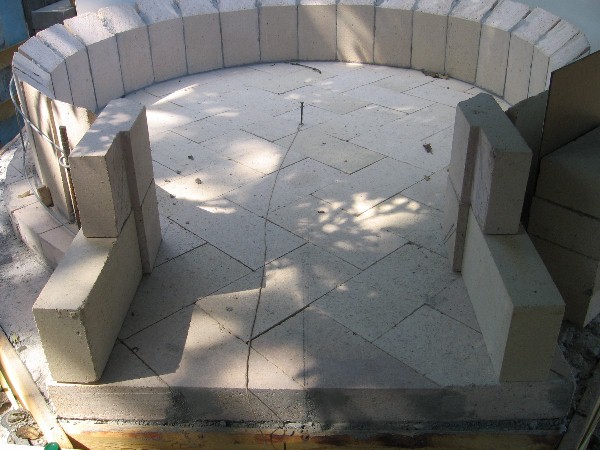Re: Mortar Joints
You could build the oven with no mortar, technically, but practically, the simple answer is: Keep the joints as small as possible on the face and don't worry about them on the back side.
Mortar is not used to hold brick together, it is there to hold them apart, i.e. fill in the gaps of imperfect units and allow a manufacturing tolerance to be established. This is why good firebrick are dry pressed, not wire cut; the designed tolerance for fireplaces and other refractory structures is a joint of 1/8". For normal brick the design tolerance usually requires a 3/8" joint, reflecting the manufacturing capability of fired brick.
Why not make all brick by dry press? Cost and texture considerations.
X
-
Re: Mortar Joints
So here is a drawing of what I was planning on doing. Please let me know if this is even possible, with a really good blade and a wet saw. Also please keep in mind that my mind works like an engineer and the saying goes "looks good on paper but what about in the field". So I drew up my oven on AutoCAD. I have all of my angles and plan on plotting out everything to scale for my layout. Now for cutting the brick: I chose for this example my 9th and 10th ring because the angles are exaggerated the most. The bricks that are drawn on the computer are flat and need to be elevated at the rear to create the dome. So if I take a stencil of my flat 9th layer brick and overlay it with my stencil for my 10th layer brick I'll know how much needs to be shaved off and at what angle for my next (10th) ring. The blue shaded area would represent the cut. This way I could achieve a 3/8" mortar joint all around. Assuming laying brick is like drawing it on a computer haha
haha

Leave a comment:
-
Re: Mortar Joints
Because you are building a spherical object out of cubic units.
Leave a comment:
-
Re: Mortar Joints
I'm speaking out of ignorance here, but why can't 1/4" be achieved or practical?Originally posted by Tscarborough View PostUnlike normal brick and mortar, the normal joint for firebrick and refractory cement is 1/8-1/4", so that would be ideal, although not practical for an oven. Just keep them as small as possible on the interior face and don't worry about the outer joint (stuff it full of mortar).
Leave a comment:
-
Re: Mortar Joints
Unlike normal brick and mortar, the normal joint for firebrick and refractory cement is 1/8-1/4", so that would be ideal, although not practical for an oven. Just keep them as small as possible on the interior face and don't worry about the outer joint (stuff it full of mortar).
Leave a comment:
-
Re: Mortar Joints
Ok guys.... So if I could achieve a 3/8" mortar joint between all my bricks that would be ideal correct???
Leave a comment:
-
Re: Mortar Joints
I made my keystone in 3 pieces, you certainly can too. See here: http://www.fornobravo.com/forum/8/36...tml#post141968, though I imagine the way I did it is somewhat easier than the way you showed in your picture--cutting square bricks into triangles sounds tricky...
Leave a comment:
-
Re: Mortar Joints
That'll be the last thing I cut. Thanks so much for the help!
Leave a comment:
-
Re: Mortar Joints
That looks fine. Don't precut your keystone though....
Leave a comment:
-
Re: Mortar Joints
That one is 15-1/2" ceiling for a 42" oven. Soldier or sailor, just change the angle of the cut to get the ceiling height you want.
Leave a comment:
-
Re: Mortar Joints
If I reduce the 2" gap to about 1/2" like the rest it makes my dome height way to high. This can't be unique to my oven, everyone must have come across it.

Would this option be ok to do structurally??

Leave a comment:








Leave a comment: